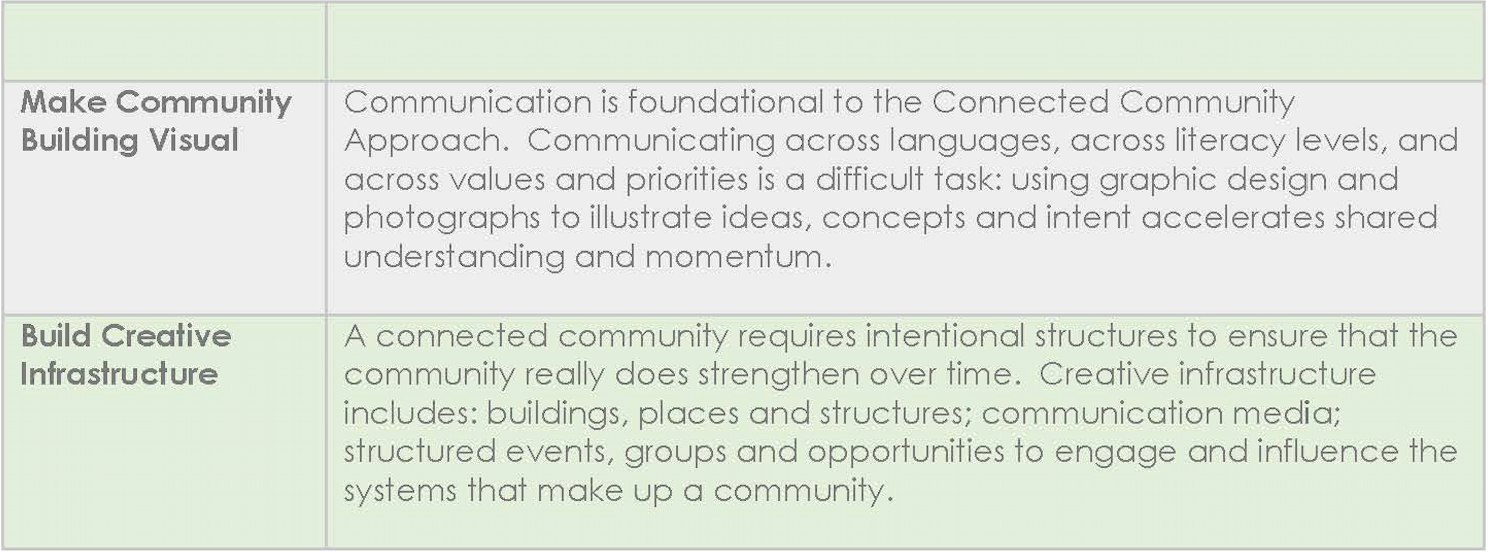
THE CONNECTED COMMUNITY APPROACH: A COMMUNITY DEVELOPMENT FRAMEWORK
How to unlock the potential of a community to find local solutions to complex social issues
Cities are made up of communities. It is at the community scale that people interact, where ideas are born and where there is a real opportunity to create meaningful change. But people in communities can also be disconnected from each other and even more disconnected from the systems that affect their lives.
The key to understanding communities is understanding how people are connected. When information, ideas, relationships, supports and resources are understood and shared across the players in a community, talents and assets can be combined and mobilized in multiple ways. When people and organizations work together in different ways over time, they begin to foster a sense of shared identity and belonging. A shared narrative begins to develop, new ideas are sparked, and with good facilitation, multiple players from multiple sectors can all play a role in continuous community improvement.
And that’s the purpose of the Connected Community Approach.
The Connected Community Approach (CCA) is a set of principles and practices that support the authentic and meaningful connection of people who want to make a positive impact in their community. By using the Connected Community Approach, an individual, organization or group, can help weave together the community building efforts of institutions and funders, grassroots groups and social service organizations, strengthening social capital, social fabric and ultimately, the resilience of their community.
Fundamental to CCA is the belief that innovation and solutions to entrenched social problems are generated through collective problem solving and rooted in local context. Working to foster connected communities may seem obvious, but it is, in fact, a paradigm shift from the way we, in North American society, invest in community interventions; interventions designed to strengthen community are often top down, isolated, and programmatic in nature.
CCA has tremendous potential to unlock the power of community building across multiple domains including (but in no way limited to): community resilience, poverty reduction, equity and inclusion and place-making.
CCA posits that there are 10 keys that when implemented together, with authenticity and intentionality, can foster the paradigm shift required to unlock the potential of connected communities.


The Connected Community Approach offers an opportunity to bring together the best of planning, design, academic theory, municipal, provincial and federal strategy, social service interventions, faith community aspirations, corporate social responsibility and ground them in the authentic goals, aspirations and realities of grassroots groups and people who have traditionally been at the margins.
Unlocking the potential of a connected community requires skill sets not often found in our community-based interventions. Using a Connected Community Approach to unlock the potential of communities requires investment: investment in capacity building, social infrastructure, but most of all in the facilitative role required to continually weave together the social fabric that communities need to effectively find local solutions to complex social problems.
Early research into the pioneering work of the East Scarborough Storefront and Community Capital work in the United Kingdom indicate that the investment is time, money and effort well spent.
Given the complex issues before us and, given what we know about the importance of community as the focal point of change...can we afford not to invest in connected communities?